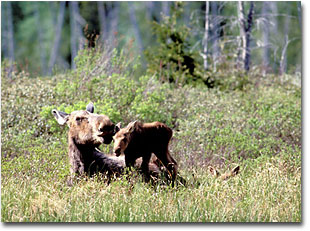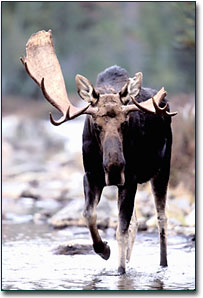Moose may be the easiest of the large mammals of North America to photograph. That's partly because they're very large targets-real frame fillers. Moose are North America's largest game animals and the world's largest deer. They are also a "laid-back" breed, despite their size and bulk, and also possess a real ability to do damage.
Anyone with a point and shoot camera should be able to get a decent picture of some of these wonderful creatures. However, for the serious wildlife photographer, finding a moose to photograph is just the beginning. Finding photogenic moose and getting close enough to them for the images that count can be more difficult than you might think. You see, in wildlife photography there are pictures that represent a species, and then, there is art. I strive for art. To have the best chance for success, it pays to know your moose.
 Which moose are the most photogenic? That depends on the season. For the next few months, all adult moose will be anything but photogenic. That's because they are shedding their winter coats. The trick is to find either a moose in the right setting or a recently born calf. The young moose calf, however, comes complete with perhaps nature's best guardian: the mother moose. Beware of the mad mother moose, but more on that in a moment.
Which moose are the most photogenic? That depends on the season. For the next few months, all adult moose will be anything but photogenic. That's because they are shedding their winter coats. The trick is to find either a moose in the right setting or a recently born calf. The young moose calf, however, comes complete with perhaps nature's best guardian: the mother moose. Beware of the mad mother moose, but more on that in a moment.
Let's look at the other most photogenic of moose: bulls during the rut. By mid- September, the bulls have shed the velvet from their antlers and polished their hardened racks, and they look good!
Two problems present themselves for the camera hunter who wants a trophy bull moose for his or her files. First, during the rut, the bull moose abandon normal feeding routines and can be difficult to find. You really have to work at locating them. You need to get out and hike the trails around the open spaces, bogs and ponds, where moose might be looking for a mate. I'd recommend that camera hunters avoid the open hunting seasons on moose to avoid conflict with sportsmen. Second, a rutting bull moose is unpredictable andalmost as dangerous as a mad mother moose.
Just how dangerous is any moose? A few excerpts from my 1993 book, The Maine Moose Watcher's Guide, should inform camera hunters:
There are three basic rules to avoid moose trouble:
- Hell hath no fury like a mad mother moose. Always remember that.
- Bull moose in the rut have the right of way. Always remember that too.
- You cannot outrun an angry moose. It pays to remember that.
Some mother moose are much more tolerant than others. I have been allowed to stay within 300 feet of many moose calves of all ages. I have also been in big trouble when I got within 300 feet of a month old calf I never even saw! It was stashed in the woods while its Mom fed in a pond. Mom spotted me and flared her mane and dropped her ears in warning. Then she came at me with a "look" in her eye. I gave up ground as calmly as that "look" allowed. After I was 300 feet from where I realized the calf must be hidden, Mom calmly resumed feeding. That 300 feet was her "fight or flight" distance.
If the calf was hidden, how did I know where it was? Because Mom kept shooting a glance in that direction...
Remember that mother moose have a difficult job to do in an uncertain and at times unkind world. Don't add to their problems. The safety of a moose calf could also be at risk if its Mom gets in a panic.
 Now let's consider bull moose during the rut... Never approach too close to a rutting bull moose. What's too close? As with mother moose, that depends upon the circumstances - and the moose. If the bull has a cow friend nearby he will probably regard you as a nuisance. He might even consider you to be a rival! Don't be surprised if you get threatening looks. And don't ignore those looks.
Now let's consider bull moose during the rut... Never approach too close to a rutting bull moose. What's too close? As with mother moose, that depends upon the circumstances - and the moose. If the bull has a cow friend nearby he will probably regard you as a nuisance. He might even consider you to be a rival! Don't be surprised if you get threatening looks. And don't ignore those looks.
The response of a rutting bull may well be to "drive away or fight" if you do get too close. Watch the bull's body language. If he drops his ears or bristles his mane, you're in big trouble! Heed his warnings!
Moose have been clocked at 35 miles per hour... You cannot outrun one. So if you ever meet one on the trail, don't run the other way! Get off the trail into the woods and slip behind some trees. In the very unlikely event that the critter follows you, find a tree to climb. Fast.
The best way to avoid trouble with moose is to use good common sense. Treat all moose with respect. And remember why God made telephoto lenses.
That's just what I did for one of this month's set of images. I spotted this moose family while mother fed in a pond in the Maine woods during the first week of June. I approached from downwind quietly when mother had her head under water, and I "froze" each time she looked up. Knowing that moose don't see very well, but have an acute sense of smell and an excellent hearing, you'll figure out how to approach such a moose.
When I got close, I covered myself with a cloth camouflage blind that I always carry in when camera hunting, and moved into camera position less than 150 feet away. Using a 400mm 3.5 Nikkor lens, sometimes with a 1.4 teleconverter, I metered off the average green vegetation around the moose family and shot 7 rolls of 36 exposure Fujichrome RDP on some of the most precious of moose moments.
Some people think that a few of those frames are art.
Catch yours in the good light.
BS-NPN 012
http://camerahunter.com
Comments on Bill Silliker, Jr.'s The Camera Hunter articles? Send them to the editor.
Maine wildlife & nature photographer Bill Silliker, Jr. – The Mooseman - photographed at many wild places in North America, with the results published in magazines internationally and in 9 of his own books. Bill was an instructor of wildlife and nature photography for L. L. Bean's Outdoor Discovery Program and a member of the Fuji Film Talent Team. Read more about Bill on the Camera Hunter archives page.



